The past couple of months, organizations have seen an enormous spike in adoption of modern tools like Microsoft Teams. It’s a bit comical (and infuriating) that it would take a worldwide pandemic for a majority of users to see the benefits of using such productivity-enhancing tools. But nevertheless! What is important now, is that organizations make the most out of this positive trend, and continue to ride this wave of adoption. On June 2nd, we hosted a webinar on this topic, “Sharpen Your Digital Leadership” where we invited Microsoft Sweden HR Lead, Helena Sjöberg, to an online Teams Live Event. If you missed it, you can see the full webinar here. Or you can read the blog post below to get the synopsis.
The importance of Digital Leadership
In today’s connected, virtual world, digital leadership is becoming more and more important and something organizations need to prioritize to stay ahead. When we talk about “digital leadership”, it is not just about growing the digital skills of the managers in your organization. Digital leadership can be demonstrated by anyone – no matter role, age or experience. The important thing is to ensure this is part of your organizations’ strategic priorities.
The following 5-step approach can be used as a framework within your organization to drive digital leadership. Please feel free to use and share.
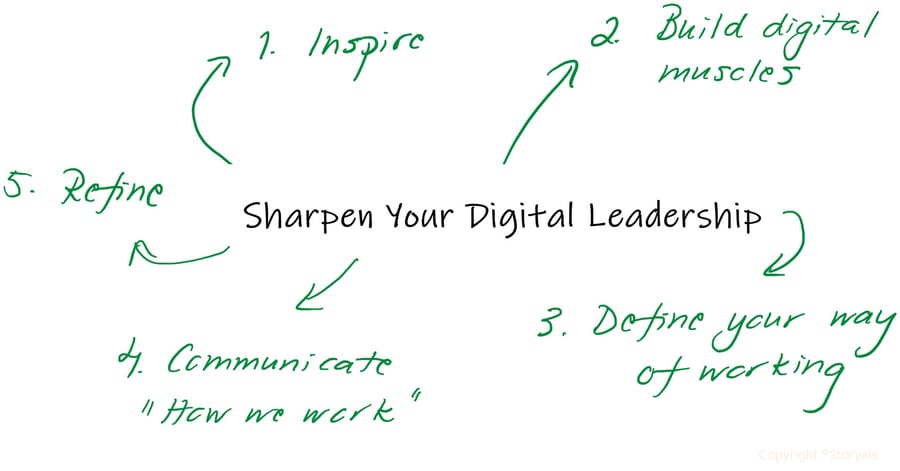
1. Inspire your employees
In order for people to see what is possible and to be encouraged to try new things, they need to get inspiration. Users can get inspired by attending an event or an online webinar, watching an online video or just seeing someone they know do something they haven’t seen before. Personally, I get a lot of inspiration from various events such as Microsoft Inspire and Ignite. I also get inspiration from other experts via LinkedIn, through blogs and various online conferences. Some people in your organization will have a built-in desire to learn how to work smarter using technology, and they will find inspiration themselves. But others you might need to “spoon-feed”. Whether you are driving a digital leadership program within your own team, department or across the entire company, think of ways to spread inspiring stories. Have you seen someone deliver a great online workshop using apps like Microsoft Whiteboard? Do you have a success story from a department that has enhanced teamwork by switching from email to collaborative channels in Teams? Perhaps someone set up a Teams Live Event to host a webinar for a big group of people? Try to find the stories and share them. If you can’t find them internally – invite external speakers to come inspire you! Another idea, that was shared by Helena Sjöberg in the webinar, is to introduce a program of “reverse-mentoring.” Set up a program where your new joiners mentor your long-time employees, to provide them with new perspectives on how technology can be used. There is definitely a big gap in terms of the tools we use in our daily lives. I often refer to the video “A Millennial Job Interview” from Dream Reach Media to demonstrate this.
2. Build digital muscles
Once the spark has been lit – you need to provide your users with the learning they need to deliver on what they have been inspired to try. However, seeing someone deliver an awesome workshop using Microsoft Teams is not the same thing as delivering one yourself. Also, using Microsoft Teams for chat and online meetings might be quite intuitive for a lot of people (especially if they are used to Skype for Business), but working together in digital teams in Microsoft Teams is a whole new ball game. Here users really need to learn new skills in terms of how to address people using mentions, how to mute annoying group chats, and how to tweak notification settings to get much-needed focus time. Many users I know have no idea about the many powerful Office apps they have access to in their Microsoft 365 subscription that can help them work in new, modern ways. Did you for instance know that you can create really cool, digital online “brochures” or newsletter in Sway? Did you know that you can quickly collect and visually summarize information via online surveys using Forms? Or that you can manage your entire group’s action items in Planner, or get a summarized view of all your own tasks in To Do?

To build digital muscles you need to provide your users with the essential “know-how” they need to work smarter. Whether you do this through online learning, via 1-1 coaching or internal “Brown bag” sessions – doesn’t matter, but it needs to be done if you want to drive digital leadership. At Storyals we provide numerous options for helping your organization build digital muscles (if your company has invested in Microsoft 365 subscriptions). A very affordable service offering is our “Digital Community Gym.” This is a managed training program for whole organizations – or smaller teams or departments within an organization (with a minimum of 50 users), delivered via Microsoft Teams. Users get access to Storyals’ unique story-based, digital learning solution in combination with ongoing guidance by our productivity experts. Users get inspiration and earning via online meetings, continuous tips and tricks and answers to any questions related to working smarter with the Office apps in Microsoft 365 – right from within Microsoft Teams. Please feel free to reach out to us if you want to learn more about this offering.
When you implement a program for building digital muscles, don’t forget to make that an integral part of your onboarding process. It is an absolute necessity for your new joiners to master the tools they are expected to use to get their daily work done.
3. Define “Your way of working”
Once your project managers, department heads and other team leaders know how to use the various tools they have access to work smarter, they need to define for themselves how they want to work. Does it make sense to set up a team in Microsoft Teams for all communication and ditch internal email? If so, what channels do you need to create to communicate effectively? Do you share and collaborate on documents with a lot of various internal and external users? If so, perhaps a SharePoint site where you collaborate on documents is a better alternative? Would it make sense to use Planner to keep track of your team’s action items? Evaluate what works best and then define “Your way of working”. This doesn’t have to be set in stone, but you need to make a conscious call and stick to it. It’s really counter-productive to use email one day, a channel post in Teams on the same topic the next day and to have follow-up actions scattered across multiple apps.
A couple of years ago, I decided to fully transition to Microsoft Teams for all internal communication and collaboration within our company. I decided that email was only for external communication with partners and customers. Our younger employees got with it right away (since they had never used Outlook before) – it was a bit more challenging for the more experienced workforce. But once they saw the benefits, they became good advocates!
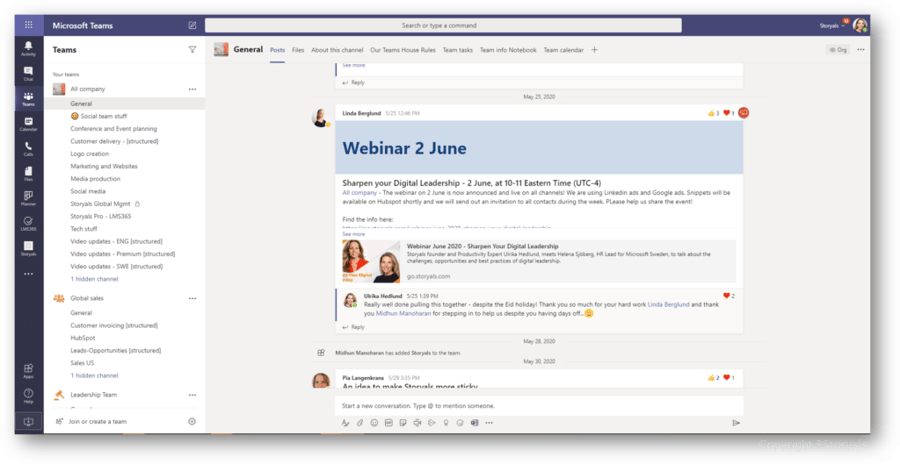
It took way longer for me to become a fan of Planner. It was first when I got inspired and saw a product manager from Microsoft demonstrate how she uses Planner to plan her weekly team tasks that I gave it another go. Now we use it to keep track of all our various “to-do’s” we need to get done.
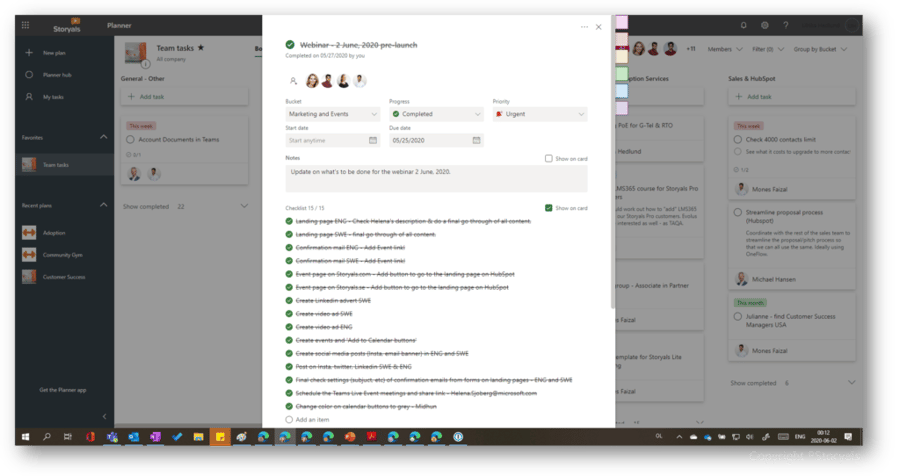
If you have digital leaders that like me, are very fond of innovation, they are likely to jump on the latest tools and apps just because they are shiny and new. Very well captured by Malin Wigner in her illustration of the technology adoption life cycle.
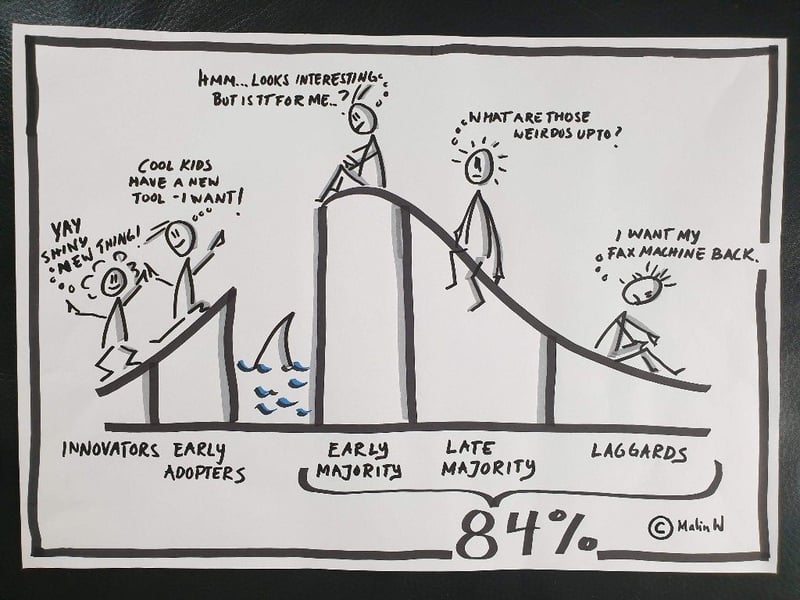
Remember that changing people’s behavior takes time and effort. Sometimes newer isn’t always better. When I, in my new-found love for Planner, suggested that we change our social media planning from OneNote to Planner, our Communications Manager asked the very sound question – Why? Since the benefits didn’t outweigh the hurdle of changing, we stuck to our “old” activity planning and tracking process in OneNote.
4. Communicate “How we work”
Once you have decided how you want to work, you need to communicate that clearly and repeatedly with your team. One of the biggest challenges for many users today, is that they are assigned to work on so many different projects in numerous, disparate teams. Having to change – not only team members and tasks, but also how work gets done, adds to the stress level of your employees. Ensure your leaders clearly communicate with their workgroups what is expected from them in terms of “how to work”. When I decided to move all our internal communication and collaboration to Teams, I set up some Teams “House Rules.” You can learn more about them and also download a copy here.
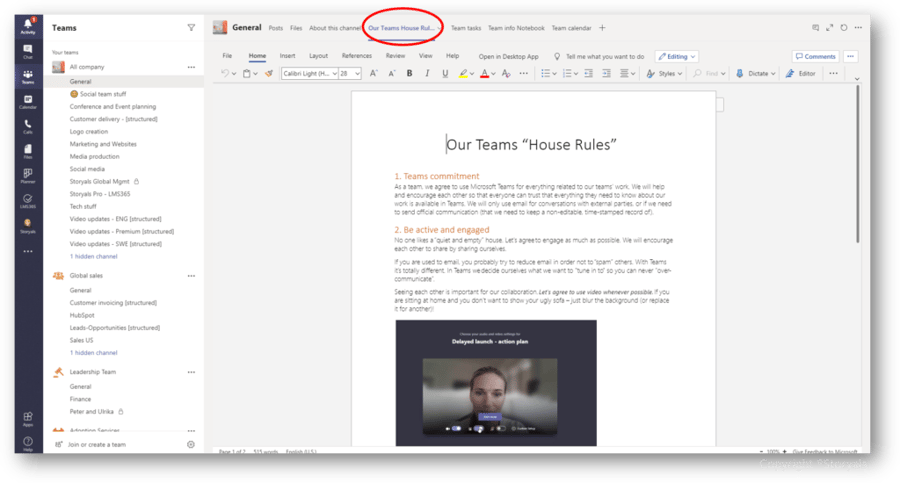
In these house rules we share how we as a team work – for instance, we commit to using channels to post messages internally – instead of emailing one another. We agree to have our cameras on during meetings, and to be supportive and engaged by using expressions, etc. In each of the channels we have a description “About this channel” so that users know what it is to be used for and how to engage. In addition to having this written down, you constantly need to remind, encourage and educate one another.

5. Refine
If there is something that is certain, it is that everything changes. Especially in the world of digital leadership. Microsoft recently introduced a number of exciting new technology enhancements during their Build 2020 conference. One example is Microsoft Lists, which are really powerful online lists that you can use to visually track information such as customer lists, product lists, issue lists, action lists, etc.

Another exciting announcement was around Teams templates where we can define a template for teams so that we don’t have to “re-create” the wheel and create channels and tabs every time we want to set up a team for a project or a new department. These are just a few examples of things that are coming that we can use to work smarter.
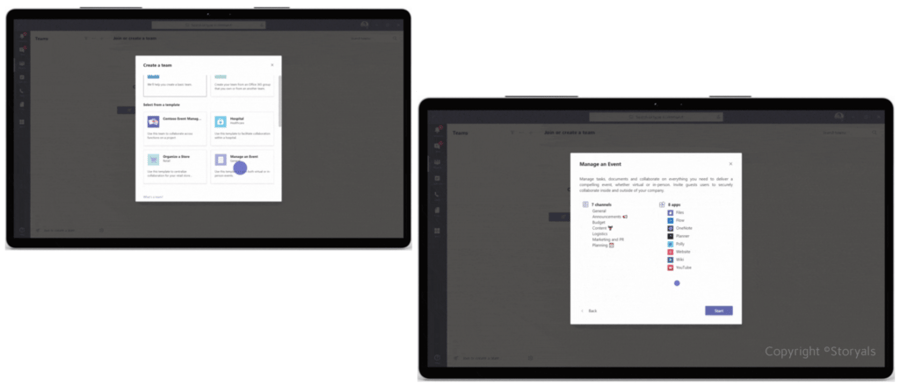
To continuously sharpen your digital skills, you need to continuously refine the way you work and the technology you use do things. But in order to do that you to get inspired and try new things, and there the cycle starts all over again!
